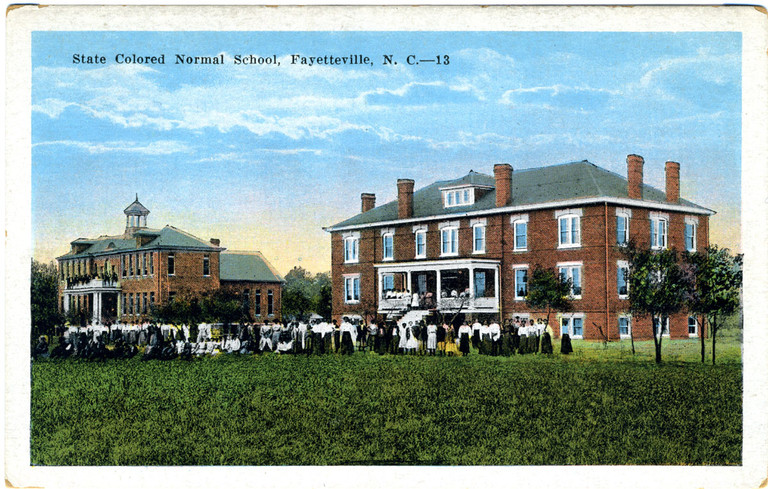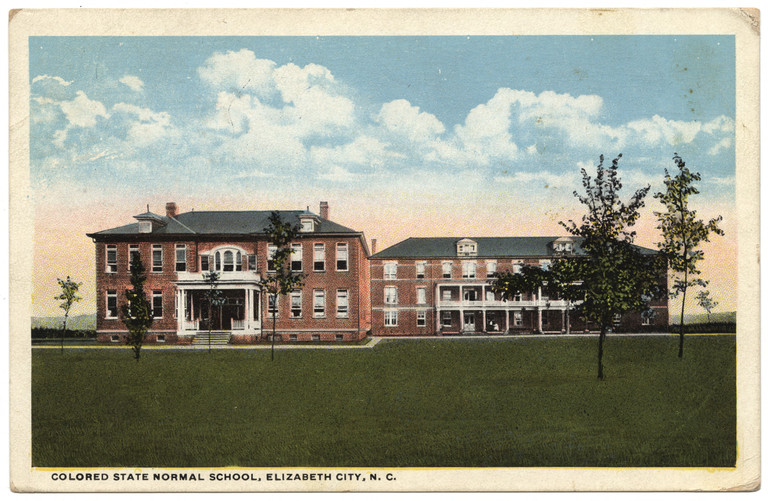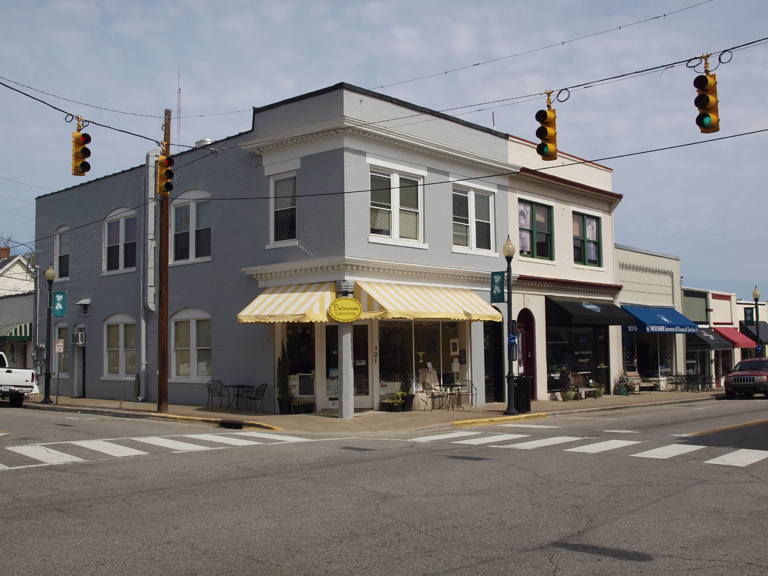Simpson, Frank B. (1883-1966)
Variant Name(s):
Frank Buchanan Simpson
Birthplace:
Raleigh, North Carolina, USA
Residences:
- Raleigh, North Carolina
Trades:
- Architect
Building Types:
Styles & Forms:
Art Deco; Colonial Revival; Gothic Revival; Neoclassical Revival
Frank B. (Buchanan) Simpson (January 6, 1883-November 18, 1966), an architect who practiced for many years in his native Raleigh, had a prolific practice that extended to other communities throughout the state and possibly beyond. On the 1940 National Census of Engineering and Architectural Personnel, he listed his occupation as “general architecture.” Working in a variety of styles from Beaux Arts classicism to Art Deco, he planned municipal, residential, and commercial buildings but was best known as a specialist in school buildings. Although he never listed a formal partner, he worked with several architects and builders over the years, including architect P. Thornton Marye of Atlanta, builder Joe. W. Stout of Sanford, and C. Eugene Savage, a Raleigh school designer.
Simpson was the son of Dr. John A. Simpson, a Virginia native, and Narcissa J. Simpson of North Carolina. Both his parents taught at the North Carolina Institute for the Education of the Deaf, Dumb, and Blind, his mother as a teacher of the blind and his father as musical director and teacher of mathematics. Simpson briefly attended the North Carolina College of Agricultural and Mechanical Arts, now North Carolina State University. The College’s 1897-1898 Annual Catalogue listed him as a student in the Sub-Freshman Class, a class designed to provide a technical education to young men unable to enroll as freshmen, but his name did not appear in subsequent catalogues. In 1900 at age 17 he was living in his parents’ household on W. Jones St. in Raleigh. It is said that he left Raleigh for a time and worked as a draftsman in cities such as Pittsburgh, Chicago, and New York. After returning to Raleigh, he married Carrie Lewis Barns of Elm City, North Carolina in 1907, and by 1910 they had two daughters, Frances and Carrie Ann.
Simpson was involved in planning several prominent buildings in Raleigh. The 1910s brought two prestigious projects for Beaux-Arts edifices in which he was the local architect working in association with the prominent Atlanta architect, P. Thornton Mayre: the State Administration Building of 1913 and the Wake County Courthouse of 1915, the latter built to replace an earlier courthouse. Among his own Raleigh projects, he planned the Electrical and Engineering Building (now Winston Hall), in 1910 at present North Carolina State University, the Haywood Store Building on Fayetteville Street, and the multi-storied Vance Apartments near the State Capitol. His best-known work in Raleigh is the Capital Club Building, a skyscraper office structure built in 1930 for a men’s club of which Simpson was a member.
Simpson also took commissions for projects in several small towns. In Apex in 1911, the directors of the Merchants and Farmers Bank hired Simpson and contractor Joe Stout of Sanford to rebuild their structure after the “Great Fire” that year destroyed their previous building. The brick, classically detailed building housed the bank on the first floor and the H. C. Olive Store on the second floor. On September 15, the Apex Journal celebrated the recovery from the fire and acclaimed Simpson’s building as “the handsomest bank building in Wake County outside of Raleigh.” Simpson and Stout collaborated again in 1917 on a substantial bungalow in Apex for Lindsay Olive. During the same period, Simpson designed such buildings as the # Littleton National Bank # in 1912, the large, columned Charles T. Sinclair House in Carthage in 1914, and the Lorraine Hotel in Lumberton in 1916.
Simpson developed a strong reputation as school specialist and evidently found favor with clients who sought well-designed and functional facilities on limited budgets. Especially important were his structures for the Colored Normal schools in Fayetteville and Elizabeth City, now Fayetteville State University and Elizabeth City State University, in 1907 and 1908, respectively. He continued to serve Fayetteville State, where he repaired the roofs of Hood Hall, a boy’s dormitory, and Taylor Science Hall in 1949 and did additional repairs on Cook Dining Hall in 1950; in the same year he worked with architect Marion A. Ham to design and build the college’s auditorium and a girls’ dormitory. Besides these college projects, he planned graded schools all across the state, from the Elizabeth City Graded School (1908) in the east to Marshall High School (1925) in the west. His post World War II schools included Enfield Graded School in 1950 with designer C. Eugene Savage, and Cary’s Kingswood Elementary School in 1953, also with Savage. His school designs, following current prototypes promoted for public schools, typically featured long, symmetrical façades with a central main block and restrained detailing. The drawings for the Kingswood Elementary School are held at Special Collections Research Center, North Carolina State University Libraries, Raleigh, North Carolina.
On November 20, 1966 the Raleigh News and Observer reported Simpson’s death in Raleigh at the age of 83. At that time he lived at 501 North Person Street and was survived by both of his daughters, three grandchildren, and seven great-grandchildren. His funeral was held on November 21 at Mitchell Funeral Home, and he was buried in Raleigh’s Oakwood Cemetery.
- Department of Administration State Construction Office, Contracts File, 1920-1958, North Carolina State Archives, Raleigh, North Carolina.
- Moses N. Amis, Historical Raleigh with Sketches of Wake County (From 1771) and Its Important Towns; Descriptive, Biographical, Educational, Industrial, Religious (1913).
- “Apex Historic District,” National Register of Historic Places nomination (1993).
- “Enfield Graded School,” National Register of Historic Places nomination (2009).
- North Carolina College of Agricultural Arts, Annual Catalogues (1897-1898, 1899-1900).
- North Carolina Department of Public Instruction, “Biennial Report and Recommendations of the Superintendent of Public Instruction of North Carolina to Governor Charles B. Aycock for the Scholastic Years 1902-1903 and 1903-1904,” (1904), http://www.archive.org/details/biennialreportrespi1902nort.
- Raleigh Historic Districts Commision, “Raleigh Landmarks, The Early Twentieth Century, 1900-1945” (2010).
- The Robesonian, Jan. 10, 1916; Aug. 31, 1916.
- “Obituary of Frank B. Simpson,” News and Observer, Nov. 20, 1966.
- Frank Simpson Folder, Charlotte Vestal Brown Papers, Special Collections Research Center, North Carolina State University, Raleigh, North Carolina.
- Who’s Who in the South (1927).
Administration State Construction Office
Contributors:Frank B. Simpson, architectDates:1939
Location:Raleigh, Wake CountyStreet Address:202 W Jones St, Raleigh, NC
Status:Standing
Type:Public
Aycock Hall
Contributors:E. J. Humphrey, builder; Frank B. Simpson, architectVariant Name(s):Fayetteville State University; Administration Building
Dates:1908
Location:Fayetteville, Cumberland CountyStreet Address:Fayetteville State University Campus, Fayetteville, NC
Status:No longer standing
Type:Educational
Note:The buildings Simpson designed in 1907 for present Fayetteville State University are probably those shown in this postcard view.
Bias Hall
Contributors:Frank B. Simpson, architectVariant Name(s):Elizabeth City State University
Dates:1938
Location:Elizabeth City, Pasquotank CountyStreet Address:Elizabeth City State University Campus, Elizabeth City, NC
Status:Standing
Type:Residential
Note:This addition is based off of the written name of a dormitory that Simpson put on his National Defense Survey that is hard to read, but is likely to be Bias Hall.
Capital Club Building
Contributors:Frank B. Simpson, architectDates:1930
Location:Raleigh, Wake CountyStreet Address:16 W. Martin St., Raleigh, NC
Status:Standing
Type:Commercial
Charles S. Brewer House
Contributors:Frank B. Simpson, architectDates:1920
Location:Henderson, Vance CountyStreet Address:107 N. Clark St., Henderson, NC
Status:Standing
Type:Residential
Note:Simpson’s drawings for the house have remained in the family.
Charles T. Sinclair House
Contributors:Frank B. Simpson, architect; John C. Stout, builderDates:1914
Location:Carthage, Moore CountyStreet Address:403 McReynolds St, Carthage, NC
Status:Standing
Type:Residential
Images Published In:Catherine W. Bishir and Michael T. Southern, A Guide to the Historic Architecture of Piedmont North Carolina (2003).
Cook Dining Hall
Contributors:Marion A. Ham, architect; Frank B. Simpson, architect (1950)Variant Name(s):Fayetteville State University
Dates:1950 (repair)
Location:Fayetteville, Cumberland CountyStreet Address:Fayetteville State University Campus, Fayetteville, NC
Status:Standing
Type:Educational
Electrical and Engineering Building
Contributors:Frank B. Simpson, architect; C. V. York, contractorVariant Name(s):Winston Hall
Dates:1910
Location:Raleigh, Wake CountyStreet Address:North Carolina State University Campus, Raleigh, NC
Status:Standing
Type:Educational
Elizabeth City Graded School
Contributors:Frank B. Simpson, architectDates:1902
Location:Elizabeth City, Pasquotank CountyStreet Address:East side of Pool St. between Pearl St.and Poindexter St. canal, Elizabeth City, NC
Status:No longer standing
Type:Educational
Enfield Graded School
Contributors:C. Eugene Savage, designer; Frank B. Simpson, architectDates:1950
Location:Enfield, Halifax CountyStreet Address:700 Branch St., Enfield, NC
Status:Standing
Type:Educational
Glenwood School
Contributors:B. F. Montague, chairman of building commission; Frank B. Simpson, architectDates:1916
Location:Raleigh, Wake CountyStreet Address:Raleigh, NC
Status:Standing
Type:Educational
Note:Listed in Manufacturers’ Record (March 16, 1916).
Haywood Store Building
Contributors:Frank B. Simpson, architectDates:1925
Location:Raleigh, Wake CountyStreet Address:205 Fayetteville St., Raleigh, NC
Status:Standing
Type:Commercial
Hood Hall
Contributors:Frank B. Simpson, architect (1950)Variant Name(s):Fayetteville State University
Dates:1950 (renovated)
Location:Fayetteville, Cumberland CountyStreet Address:Fayetteville State University Campus, Fayetteville, NC
Status:Standing
Type:Educational
Residential
Kingswood Elementary School
Contributors:C. Eugene Savage, designer; Frank B. Simpson, architectDates:1953
Location:Cary, Wake CountyStreet Address:519 Ferrell St, Cary, NC
Status:Standing
Type:Educational
Lane Hall
Contributors:Frank B. Simpson, architectVariant Name(s):Elizabeth City State University
Dates:1908
Location:Elizabeth City, Pasquotank CountyStreet Address:Elizabeth City State University Campus, Elizabeth City, NC
Status:Standing
Type:Educational
Images Published In:The Viking, Elizabeth City State University (1986-1987).
Note:The buildings Simpson designed in 1908 for present Elizabeth City State University are probably those shown in this postcard view.
Littleton National Bank
Contributors:M. S. Davis, associated architect; Frank B. Simpson, architectDates:1912
Location:Littleton, Halifax CountyStreet Address:Littleton, NC
Status:No longer standing
Type:Public
Lorraine Hotel
Contributors:J. E. Beaman, contractor; Frank B. Simpson, architectDates:1916
Location:Lumberton, Robeson CountyStreet Address:Chestnut St. at Courthouse Square, Lumberton, NC
Status:No longer standing
Type:Commercial
ResidentialNote:Listed in Manufacturers’ Record (April 13, 1916). The hotel was constructed after a larger facility that was probably planned by Joseph F. Leitner was cancelled because of financial problems (The Robesonian, June 22, 1914, Jan. 10, 1916, Aug. 31, 1916).
Lumberton Hotel
Contributors:Dates:1916
Location:Lumberton, Robeson CountyStreet Address:Chestnut St. at Courthouse Square, Lumberton, NC
Status:Unknown
Type:Commercial
Note:The Manufacturers’ Record of April 13, 1916, noted that the Lumberton Hotel Company had let a contract to J. E. Beaman of Raleigh to build the hotel designed by Frank B. Simpson. There is no known hotel of this era in downtown Lumberton now.
Marshall High School
Contributors:Frank B. Simpson, architect; Mack Sprinkle, builderDates:1926
Location:Marshall, Madison CountyStreet Address:W. Bridge St., Blannahassett Island, Marshall, NC
Status:Standing
Type:Educational
Merchants and Farmers Bank
Contributors:Frank B. Simpson, architectVariant Name(s):H. C. Olive Store
Dates:1917
Location:Apex, Wake CountyStreet Address:101-103 N. Salem St., Apex, NC
Status:Standing
Type:Commercial
PublicNote:The postcard view of downtown Apex in the early 20th century shows the bank on the left.
Olive-Seymour House
Contributors:Frank B. Simpson, architect; Joe W. Stout, contractor; Joe W. Stout & Co., contractorsDates:1917
Location:Apex, Wake CountyStreet Address:107 S. Salem St., Apex, NC
Status:Standing
Type:Residential
Seabrook Auditorium
Contributors:Marion A. Ham, architect; Frank B. Simpson, architectVariant Name(s):Fayetteville State University
Dates:1953
Location:Fayetteville, Cumberland CountyStreet Address:Fayetteville State University Campus, Fayetteville, NC
Status:Altered
Type:Educational
Smith Hall
Contributors:Marion A. Ham, architect; Frank B. Simpson, architectVariant Name(s):Fayetteville State University
Dates:1953
Location:Fayetteville, Cumberland CountyStreet Address:Fayetteville State University Campus, Fayetteville, NC
Status:Standing
Type:Educational
Residential
State Administration Building
Contributors:P. Thornton Marye, architect; Frank B. Simpson, associated architectVariant Name(s):Ruffin Building
Dates:1913
Location:Raleigh, Wake CountyStreet Address:1 West Morgan St., Raleigh, NC
Status:Standing
Type:Public
Note:As state government required more space in the early 20th century, a plan was developed to enlarge the North Carolina State Capitol (see Frank Pierce Milburn). But an outcry stopped that project, and instead the State Administration Building was erected facing Union Square, taking design cues from the State Capitol. Marye’s drawings for the State Administration Building are in the North Carolina State Archives, Raleigh. Several architects sought the commission. According to the Asheville Gazette-News of June 8, 1911, “the fight to become the architect of the state administration building occupied most of the day yesterday before the building committee.” After other contenders were eliminated, the vote was three and three for Hook and Rogers of Charlotte and P. Thornton Marye of Atlanta, until a deciding vote went for Marye. “Some of the North Carolina architects have criticised the committee for giving the work to an out-of-state company.” Marye was associated for the project with Frank B. Simpson of Raleigh. The building was to contain spaces for the Supreme Court, the state library, the hall of history, and numerous officers and commissions.
Taylor Science Hall
Contributors:Frank B. Simpson, architectVariant Name(s):Fayetteville State University
Dates:1939
Location:Fayetteville, Cumberland CountyStreet Address:Fayetteville State University Campus, Fayetteville, NC
Status:Standing
Type:Educational
United States Post Office and Courthouse
Contributors:William Henley Deitrick, architect (1938); Patrick Linehan, contractor (1870s); Alfred B. Mullett, supervising architect of the Treasury (1874-1879); Frank B. Simpson, architect (1912-1913)Variant Name(s):Century Post Office; Federal Building
Dates:1874-1879; 1912-1913 [remodeled]; 1938 [expanded]
Location:Raleigh, Wake CountyStreet Address:314 Fayetteville St., Raleigh, NC
Status:Standing
Type:Public
Images Published In:Catherine W. Bishir, Charlotte V. Brown, Carl R. Lounsbury, and Ernest H. Wood III, Architects and Builders in North Carolina: A History of the Practice of Building (1990).
Linda L. Harris and Mary Ann Lee, An Architectural and Historical Inventory of Raleigh, North Carolina (1978).
Elizabeth Reid Murray, “Wake County’s Courthouses Through Two Centuries (1771-1970), “ unpublished typescript, copy in State Library, Raleigh, North Carolina, copy courtesy of Elizabeth Reid Murray.
Lawrence Wodehouse, “Alfred B. Mullett’s Court Room and Post Office at Raleigh, North Carolina, “ Journal of the Society of Architectural Historians, 26.4 (Dec. 1967).Note:A landmark on Raleigh’s Fayetteville Street, the Second Empire style edifice retains its essential character despite the alterations of the 20th century that toned down its ebullient design by removing its chimneys, changing the dormers, and installing a columned entrance, and adding a large rear extension.
Vance Apartments
Contributors:Frank B. Simpson, architect; Frank Upman, builderDates:1913
Location:Raleigh, Wake CountyStreet Address:Corner of N. Wilmington St. and E. Edenton St., Raleigh, NC
Status:No longer standing
Type:Residential
Wake County Courthouse
Contributors:P. Thornton Marye, architect; Frank B. Simpson, associated architectDates:1915
Location:Raleigh, Wake CountyStreet Address:Fayetteville St., Raleigh, NC
Status:No longer standing
Type:Public
Images Published In:Steven Stolpen, Raleigh : A Pictorial History (1977).
Note:The large, Beaux Arts edifice, which had a long colonnade of Corinthian columns set in antis, was razed in the late 1960s to make way for the present Wake County Courthouse.







